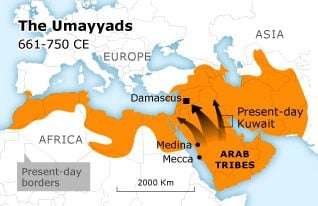
During the millennium spanning the Alexandrian and Islamic eras, Failaka and the nearby coastline probably fell under the sway of the Seleucid, Parthian, and Sassanid dynasties. The rulers of these Persia-based empires appear to have had little interest in Failaka. Virtually no literary or archaeological evidence remains of its early Christian inhabitants, who, according to Muslim sources, surrendered to the Muslim armies in the 7th century.
By then, the centre of settlement in this region appears to have shifted from Failaka to the mainland. Around 500 CE a settlement was established at Ras Kazima, near present-day al-Jahra, on the western shore of Kuwait Bay; a small oasis can still be found there.
It may seem strange that Kuwait Bay, the best natural harbour in the Gulf, experienced no substantial human settlement until modern times. Indeed, it was only during the latter 20th century that the town of Kuwait evolved into the metropolitan hub called Kuwait City. This was partly the result of ecological circumstances. The unproductive soil and scarce natural water resources of the area could not, until very recently, sustain a substantial population, much less a large city.
But there is an additional reason, with a strong contemporary resonance: the area around Kuwait Bay was highly vulnerable to attack. Directly north of Kuwait Bay loomed the continually expanding and contracting empires of Mesopotamia and Iran, with armies seeking spoils and rulers craving taxes and tribute, and from the desert plains to the south, Bedouin raiders harassed and plundered the settlements of what is now Kuwait right into modern times.
This transitional area between centralized empire and tribal desert that characterized Kuwait made for uneasy settlement, no matter how productive its soil or its fishing grounds. In the centuries before the coming of Islam, the area was the scene of several battles between Arab and imperial armies. In 623, a year after the Prophet Muhammad arrived in Medina, according to Muslim sources, one such battle between Arab and Persian forces took place near Ras Kazima.
But after the arrival of the Muslim armies in the 640s another millennium passed with little or no contemporary literary reference to the area. The only significant development during classical Islamic times seems to have been the gradual conversion of the area’s inhabitants to the new Arab religion of Islam.

